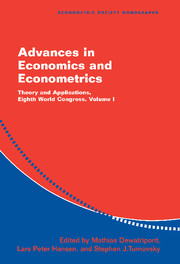Book contents
- Frontmatter
- Contents
- List of Contributors
- Preface
- 1 Auctions and Efficiency
- 2 Why Every Economist Should Learn Some Auction Theory
- 3 Global Games: Theory and Applications
- 4 Testing Contract Theory: A Survey of Some Recent Work
- 5 The Economics of Multidimensional Screening
- A Discussion of the Papers by Pierre-Andre Chiappori and Bernard Salanié and by Jean Charles Rochet and Lars A. Stole
- 6 Theories of Fairness and Reciprocity: Evidence and Economic Applications
- 7 Hyberbolic Discounting and Consumption
- A Discussion of the Papers by Ernest Fehr and Klaus M. Schmidt and by Christopher Harris and David Laibson
- 8 Agglomeration and Market Interaction
- 9 Nonmarket Interactions
- Index
8 - Agglomeration and Market Interaction
Published online by Cambridge University Press: 19 January 2010
- Frontmatter
- Contents
- List of Contributors
- Preface
- 1 Auctions and Efficiency
- 2 Why Every Economist Should Learn Some Auction Theory
- 3 Global Games: Theory and Applications
- 4 Testing Contract Theory: A Survey of Some Recent Work
- 5 The Economics of Multidimensional Screening
- A Discussion of the Papers by Pierre-Andre Chiappori and Bernard Salanié and by Jean Charles Rochet and Lars A. Stole
- 6 Theories of Fairness and Reciprocity: Evidence and Economic Applications
- 7 Hyberbolic Discounting and Consumption
- A Discussion of the Papers by Ernest Fehr and Klaus M. Schmidt and by Christopher Harris and David Laibson
- 8 Agglomeration and Market Interaction
- 9 Nonmarket Interactions
- Index
Summary
INTRODUCTION
The most salient feature of the spatial economy is the presence of a large variety of economic agglomerations. Our purpose is to review some of the main explanations of this universal phenomenon, as they are proposed in urban economics and modern economic geography. Because of space constraints, we restrict ourselves to the most recent contributions, referring the reader to our forthcoming book for a more complete description of the state of the art.
Although using agglomeration as a generic term is convenient at a certain level of abstraction, it should be clear that the concept of economic agglomeration refers to very distinct real-world situations. At one extreme lies the core-periphery structure corresponding to North-South dualism. For example, Hall and Jones (1999) observe that high-income nations are clustered in small industrial cores in the Northern Hemisphere, whereas productivity per capita steadily declines with distance from these cores.
As noted by many historians and development analysts, economic growth tends to be localized. This is especially well illustrated by the rapid growth of East Asia during the last few decades. We view East Asia as comprising Japan and nine other countries, that is, Republic of Korea, Taiwan, Hong Kong, Singapore, Philippines, Thailand, Malaysia, Indonesia, and China. In 1990, the total population of East Asia was approximately 1.6 billion. With only 3.5 percent of the total area and 7.9 percent of the total population, Japan accounted for 72 percent of the gross domestic product (GDP) and 67 percent of the manufacturing GDP of East Asia.
- Type
- Chapter
- Information
- Advances in Economics and EconometricsTheory and Applications, Eighth World Congress, pp. 302 - 338Publisher: Cambridge University PressPrint publication year: 2003
- 3
- Cited by

